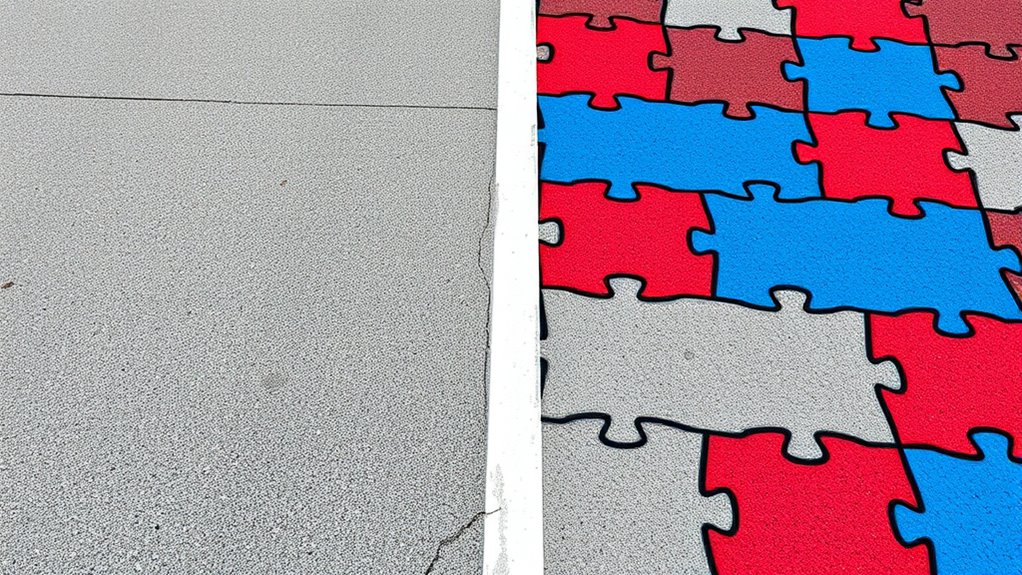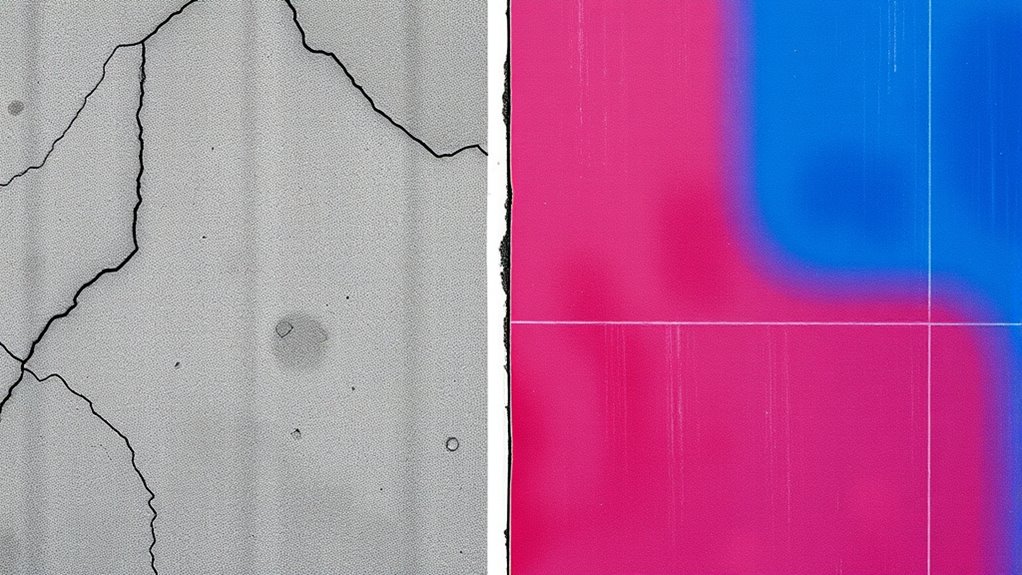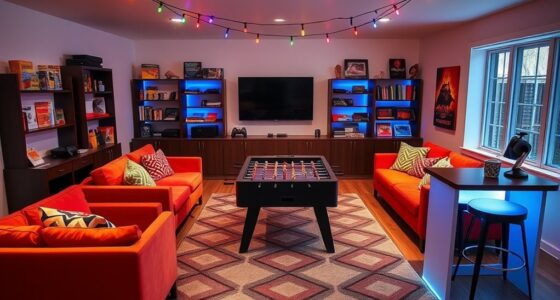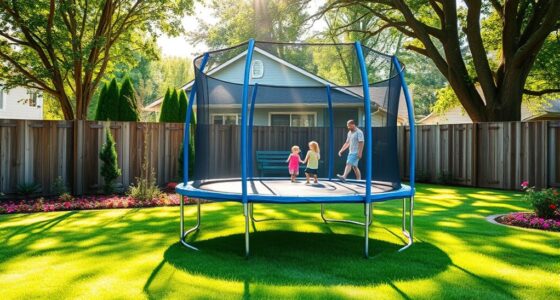When choosing between concrete and sport tiles for your basketball court, consider durability, safety, and long-term costs. Concrete offers strong weather resistance and is cost-effective upfront but can crack and lacks shock absorption, increasing injury risks. Sport tiles provide better impact absorption, easier installation, and simple maintenance, making them safer and more adaptable. While they have higher initial costs, they can save you money over time. Keep exploring to find the best fit for your needs.
Key Takeaways
- Concrete offers durability and weather resistance but lacks shock absorption, increasing injury risk during play.
- Sport tiles provide superior shock absorption and safety features, reducing joint fatigue and injury potential.
- Concrete is cost-effective initially but may incur higher long-term maintenance costs due to cracking and wear.
- Sport tiles have higher upfront costs but are easier to install, maintain, and replace, offering long-term savings.
- For outdoor courts in colder climates, concrete is suitable; sport tiles are ideal for versatile indoor/outdoor use emphasizing safety.

Are you trying to choose the best surface for your basketball court? The decision often comes down to understanding the strengths and weaknesses of concrete and sport tiles. Concrete is renowned for its durability and cost-effectiveness, making it a popular choice, especially for outdoor courts. It withstands harsh weather conditions like frost and freezing temperatures, so if you live in a colder climate, concrete can serve you well over time. Its ability to resist wear and tear ensures your court remains functional with minimal repairs. Additionally, concrete provides excellent ball bounce and response, giving players a consistent and predictable playing experience. However, it’s worth noting that concrete can crack over time if not properly maintained, and playing on it might lead to joint fatigue because it lacks shock absorption. Continuous impact can cause discomfort and increase the risk of injuries, especially to knees and lower backs. Concrete’s resilience in harsh conditions makes it a reliable option for many outdoor courts. Sport tiles offer a different set of advantages that might appeal to you, especially if safety and versatility are priorities. These modular tiles are easy to install, often over existing surfaces, and can be customized to fit any space or sport. They’re highly adaptable for indoor and outdoor use, making them a flexible choice for multi-purpose facilities. Sport tiles excel in shock absorption, considerably reducing impact on joints and lowering injury risk. This feature makes them ideal for players who want a safer environment and less fatigue during long games. With a lifespan of over 15 years and minimal upkeep, sport tiles also offer long-term savings, despite a higher initial installation cost. Plus, they’re simple to maintain—just a quick clean keeps them in good shape. Since damaged tiles can be replaced individually, maintenance and replacement costs stay manageable. When comparing durability, both surfaces perform well under different conditions. Concrete resists wear and tear and handles weather extremes, but it’s prone to cracking and doesn’t absorb impact. Sport tiles are durable, impact-resistant, and designed to adapt to changing conditions, providing a safer, more forgiving surface. Cost-wise, concrete generally costs less upfront, making it attractive for community projects with tight budgets. However, long-term maintenance costs for concrete can add up over the years, whereas sport tiles may reduce these expenses through their modular design. They also offer the benefit of individual tile replacement, which can lower overall replacement costs over time. In the end, your choice depends on your priorities. If affordability and durability are key, concrete may suit you best. But if safety, versatility, and long-term savings matter more, sport tiles could be the smarter investment. Both options have their merits, so consider how each aligns with your needs, climate, and budget before making your decision.
Frequently Asked Questions
Which Surface Is More Environmentally Friendly?
You’re asking which surface is more eco-friendly. Sport tiles generally have a lower environmental impact because they’re made from recycled materials, require less resource use, and need less maintenance. They also often feature permeable options for better rainwater management. Concrete has a higher carbon footprint due to production emissions and can require more frequent repairs. Overall, sport tiles tend to be the greener choice, especially when eco-friendly materials are used.
How Do Surface Types Affect Player Injury Rates?
Think of the court as a dance floor—your steps matter. The surface type directly influences injury rates; harder surfaces like concrete act like unforgiving concrete steps, increasing your risk. Softer, shock-absorbing surfaces like sport tiles cushion your landings, reducing joint stress and injury chances. So, the right surface acts like a gentle dance partner, helping you move safely and confidently across the court.
What Maintenance Is Required for Each Surface?
You need to keep your court in top shape by performing regular maintenance. For concrete, pressure clean every 1-2 years, sweep weekly, and resurface every 4-5 years, repairing cracks and applying acrylic coatings. For sport tiles, clean regularly with mild detergent, inspect and replace damaged tiles promptly, and guarantee proper drainage. Both surfaces benefit from routine inspections to prevent damage, extend lifespan, and ensure safe, high-quality play.
Are There Color Options Available for Sport Tiles?
Imagine your court as a blank canvas waiting for your masterpiece. With sport tiles, you get a vibrant palette of color options, including customizable hues, bold patterns, and even logos. You can choose from standard shades like black and grey or go for over 100 colors with specialized systems. This flexibility lets you create a court that reflects your style, making it as unique and dynamic as your game.
How Do Costs Compare Over the Court’S Lifespan?
When comparing costs over a court’s lifespan, concrete generally proves more economical. You’ll pay higher upfront for installation, but its durability means less frequent repairs and resurfacing. Sport tiles may be cheaper initially but require regular maintenance and replacement, adding up over time. So, if you want long-term savings and less hassle, concrete is the better choice, providing lasting value despite the higher initial investment.
Conclusion
Choosing between concrete and sport tiles isn’t just about material—it’s about what kind of game you want to play. Concrete stands like a sturdy foundation, symbolizing durability and steadfastness, while sport tiles embody flexibility and innovation, like a canvas ready for your next move. Whichever surface you pick, remember it’s more than just the court beneath your feet; it’s where your passion takes shape, turning every game into a story etched in time.









